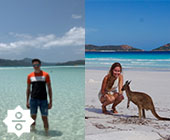Finally it was time again for the famous StudyTour, where this year we got to go to warm Brazil. Read all about it here!

Ever since I got accepted into the IBA program, I was determined to go on exchange. I have always been very interested in exploring new cultures, and since a young age I felt I had to look outside the Netherlands to become a more open-minded person.
I always wanted to live in a culture that is completely different from the Dutch culture, and so I chose to go to South-America. The South-American culture is the complete opposite of the Dutch culture, this was very appealing to me. Besides that I wanted to learn a new language and escape Europe for a while, since I travelled in 15 different countries but never managed to set foot outside of Europe.
I can safely say that getting accepted for an exchange semester in Buenos Aires, Argentina was a dream coming true.
So I spent the Fall Semester of 2016 studying at Universidad Católica Argentina (La UCA) in Buenos Aires. This university has a very good reputation in Argentina and South-America in general. One of the main benefits of studying at this university is that it is very nicely located in the middle of Puerto Madero, which is the rich Business district of Buenos Aires with loads of tall buildings and luxurious apartment complexes.
Buenos Aires is the most alive city I have ever been to. You can go out in the middle of the night on a random Tuesday and you will find a city full of activities; people having diner, going to a theatre, dancing and drinking in the middle of the street, just enjoying life.
“Buenos Aires is also one of the most fascinating cities I have ever been to in terms of its architecture and all the beautiful things there are to see. Every street is different, every building is designed beautifully and every neighborhood has its own stories. In six months’ time, I was not even able to see all the beautiful things this city has to offer.”
Housing was not taken care of by the university so we had to arrange everything ourselves. It is not difficult to find a nice flat in Buenos Aires and prices are very reasonable. I lived in about five different houses, in my opinion this is the only way to get to know a city really well. Buenos Aires is with 15 million inhabitants a huge metropolitan and diverse city, with every neighborhood being completely different. There is the neighborhood Palermo (aka Palermo Hollywood) which is famous for all its bars, restaurants and clubs and obviously most exchange students lived here. Then there is Recoleta, which is the fancy neighborhood known for all the beautiful apartment buildings occupied by rich people and the stunning Recoleta cemetery. San Telmo, another neighborhood, is the oldest ‘barrio’ of the city. Its antique stores and small streets where you find people dancing Tango are typical of this neighborhood. Then there is Almagro which is considered one of the more dangerous neighborhoods of the city, which I thought was unjustified. I think I was the only exchange student living there and no one really wanted to set foot there. I really liked the neighborhood, to me it was just a ‘normal’ Buenos Aires Barrio where the hero of Tango, Carlos Gardel, was born. Microcentro, the City Centre, is another great neighborhood famous for the Obelisk and the extraordinary shopping streets. By living in all these different neighborhoods for a while, I got to know all of them really well.
The worlds’ best steak, the worlds’ best red wine the worlds’ most passionate love for football are amongst the things the Argentine culture is famous for.
Next to this, Argentineans are very friendly and open-minded. Family and friends are very important to them, way more important than in The Netherlands. If an Argentine runs into an old friend in the street, chances are high they will go get a coffee together no matter what appointment they might be running late for. This makes ‘I ran into an old friend’ and ‘I was spending time with my family’ very reasonable excuses for running late and you are not expected to show up for a meeting less than 30 minutes after the time you were supposed to meet. The openness and friendliness of the Argentines immediately made me feel at home and there hasn’t been a minute I felt the urge to go back to Holland.
Castellano (which is Spanish with an accent) is the one and only language spoken in Buenos Aires. No one speaks English, don’t even try. I took Spanish lessons for a year at Tilburg University until I reached the B1 level. Also, I went one month earlier to Argentina to follow a Spanish language & culture intensive course at Universidad Torcuato Di Tella, which is another highly ranked university in Argentina. These daily 3-hour lessons for four weeks really improved my language abilities and by the time the semester began, I was able to properly have a conversation with a Latino or Latina and manage to get around on the streets of Buenos Aires. Four out of my five courses were taught in Spanish (!) which increased the pressure for me to learn the language. But even if this wouldn’t have been the case, I would have made sure my Spanish language skills were sufficient. In a country like Argentina, it is impossible to really integrate into the culture if you do not speak the language and by speaking the language you can learn so much more about the not-touristy things to do and get to know much more people.
A great example of this is my Argentine granddad (not really my granddad), Modesto. He was the 80-year old doorman at my apartment building and the most typical argentine I ever met. He worked the night shifts and every time I came home he would be sitting next to the door listening old Tango music and drinking mate (argentine Herbal Tea) while asking millions of questions about how my day was and what I think about Argentina. It was just impossible to enter my apartment building before speaking with him for about 30 minutes. When it was my birthday he organized an ‘Asado’ for me, which is an Argentine BBQ, because in his opinion I could not leave the country before a real Argentine cooked me a real Argentinean steak. This is the kind of experience I would have never had if I did not speak Spanish, given that Modesto obviously doesn’t know a single word of English.
South-Americans are in general very relaxed people.
My semester ended in November, and since my ticket back to The Netherlands was booked for January, I still had a full month to travel and explore other countries. During the semester I already visited Chile, Brazil and both the northern and southern part or Argentina and after the semester I decided to also visit Bolivia, Peru, Colombia and Ecuador. The highlights of my trips were definitely Brazil and Colombia. The city of Medellin and the beaches of Cartagena are just stunning. Rio de Janeiro is, next to Buenos Aires, the best city I have visited. Beautiful beaches and nature combined with great parties and happy people are key to the city. The thing that struck me the most in South-America is that people living in Favela’s having to survive with 1 dollar per day are much happier than most Dutch people. This was a real eye-opener to me as a Dutch person and definitely made me appreciate life more, realizing it is not just all about money. This would be a good experience for all Dutch people I think.
For me it is difficult to mention specific things I learned on exchange, but it is sure that I learned loads of things. I became aware of cultures that are very different from my own. I learned that life is more than just making career; having good friends and enjoying life is just as important. This international experience will definitely help me in my future since I am more able to put myself in other’ peoples shoes and see things from a different point of view.
I can definitely recommend everyone to go on exchange, the experiences are invaluable and will benefit you for the rest of your life!


Finally it was time again for the famous StudyTour, where this year we got to go to warm Brazil. Read all about it here!

Have you always wanted to go to Lisbon on exchange? In this article Phi will tell you more about his experiences. Read it here!

This article by Romano Ruijtenburg provides an insight into Scandinavian business and student life, and your opportunity to experience it yourself!

Curious to know how it is to study and travel on the other side of the world? Max van Elten and Martine Spaan share their exchange experience in Australia.